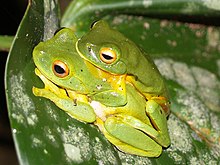
Back زواج تراكبي Arabic Amplexus Catalan Amplexus Czech Amplexus German Amplekso EO Amplexo Spanish Anplexo EU آغوشگیری FA Amplexus Finnish Amplexus French


Amplexus (Latin "embrace") is a type of mating behavior exhibited by some externally fertilizing species (chiefly amphibians and horseshoe crabs) in which a male grasps a female with his front legs as part of the mating process, and at the same time or with some time delay, he fertilizes the eggs, as they are released from the female's body.[1] In amphibians, females may be grasped by the head, waist, or armpits, and the type of amplexus is characteristic of some taxonomic groups.
Amplexus involves direct contact between male and female, distinguished from other forms of external fertilization, such as broadcast spawning, where sperm and eggs are freely shed into water without direct contact by individuals. In order for amplexus to be initiated, male frogs must first find a mate by attracting one through calls, typically in the evening.[2] Once a male has successfully attracted a mate, the process of amplexus begins, while the unsuccessful males are forced to continue their search for a mate through further calls.[2]
The competition for a female mate among males is considered intense, and it is not uncommon for a male amphibian to attack an already-amplexed pair of amphibians.[3] When a male amphibian attacks an amplexed pair of amphibians, he is trying to force the other male to release its grasp of the female, so he can then mate with her.[3] Male amphibians are also known to show mate-guarding behaviour, which is shown after amplexus, and it is the male's attempt to prevent the female amphibian from mating with other males.[3]
The duration of amplexus has been found to vary across species. In some species it may last for many days, while in others it may last a few hours.[4] Despite the variation in the duration of amplexus across species, typically all species that exhibit this behaviour have to use their forelimb muscles for the duration of amplexus.[4] Studies have found that this reproductive behaviour of amplexus can come with different fitness costs, due to the fact that amplexus can occur for prolonged periods of time. For instance, a study found that when a male amphibian is grasping and holding onto a female amphibian, this can lead to the impairment of the female's ability to move or to feed.[5] After conducting experiments, researchers confirmed that amplexus does decrease a female's locomotor performance (e.g., swimming, walking) as well as the feeding rates.[5] With regard to the cost to the male engaged in amplexus, male amphibians have been found to not feed at all during amplexus.[5]
- ^ Cite error: The named reference
:02was invoked but never defined (see the help page). - ^ a b McLister, James (2003). "The metabolic cost of amplexus in the grey tree frog (Hyla versicolor): assessing the energetics of male mating success". Canadian Journal of Zoology. 81 (3): 388–394. doi:10.1139/Z03-013.
- ^ a b c Sztatecsny, Marc; Preininger, Doris; Freudmann, Anita; Loretto, Matthias-Claudio; Maier, Franziska; Hödl, Walter (2012-09-23). "Don't get the blues: conspicuous nuptial colouration of male moor frogs (Rana arvalis) supports visual mate recognition during scramble competition in large breeding aggregations". Behavioral Ecology and Sociobiology. 66 (12): 1587–1593. Bibcode:2012BEcoS..66.1587S. doi:10.1007/s00265-012-1412-6. ISSN 0340-5443. PMC 3496481. PMID 23162205.
- ^ a b McLister, James (2003). "The metabolic cost of amplexus in the grey tree frog (Hyla versicolor): assessing the energetics of male mating success". Canadian Journal of Zoology. 81 (3): 388–394. doi:10.1139/Z03-013.
- ^ a b c Bowcock, Haley; Brown, GregoryP.; Shine, Richard (2009-02-23). "Beastly Bondage: The Costs of Amplexus in Cane Toads (Bufo marinus)". Copeia. 2009 (1): 29–36. doi:10.1643/ce-08-036. ISSN 0045-8511. S2CID 83622844.